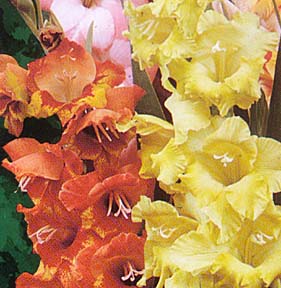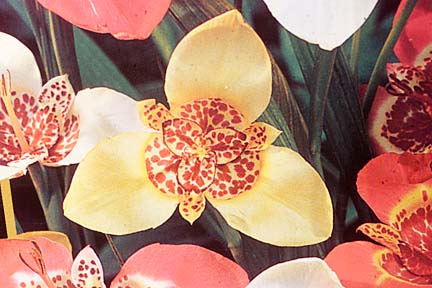


Home & Garden![]()
Friday, February 15, 2002

|
Blooming bulbs Consider what Howard Takishita of Howard's Nurseries must do every year to achieve blooming tulips of every color in the spring.
Howard Takishita knows how
to coax tulips into blooming
at just the right timeHis work begins in October when thousands of tulip bulbs arrive at his Kula nursery on Maui. He and his staff must fool the bulbs into production by creating artificial wintery conditions. The bulbs, potted and watered, are kept in cool storage for 12 to 16 weeks before they become blooming plants ready for market.

|
"First they go through pre-cooling; that's in order for them to develop their root system. We need to do that to establish the bulbs to force the flowers. Basically, we imitate the frost that they get on the mainland, and that's what really gets them going," Takishita explains.The bulbs begin in 48-degree temperature, and when the roots peek out of the bottom of the pots, the temperature is lowered to 41 degrees. The temperature is reduced to 32 to 34 degrees once the shoots reach about an inch above soil.

|
The near-freezing temperature suspends the growth of the bulbs to allow Takishita to time the tulips for market. Before he needs a shipment, he brings the plants into full sun for flower buds to form and mature, which requires 12 to 28 days depending on the variety."When the flowers get fat and fluffy and you can see the color on the tip, it means the flowers will be ready to open in a couple of days, and that's when we ship them out," he says.
Takishita has it down to a science, plus he has Kula's naturally cool climate (in the mid-70s during the day and low 60s at night) on his side. Hawaii gardeners willing to sacrifice space in their refrigerators may hope to achieve the same colorful results, but we are talking about a lot of work and experience.
"It's not easy growing the mainland-type spring flowers, but some people do try every year," says Elton Hara, garden manager for Star Market. The Moiliili store always brings a supply of bulbs, tubers and corms in the spring to satisfy determined gardeners. But most consumers are content buying the tulips, hyacinths, narcissuses, daffodils and other spring flowers as blooming plants.
Place: Urban Garden Center, 962 Second St., Pearl City Flowers & Ornamentals from Bulbs, Tubers & Corms
Time: 9:30 to 11 a.m., Feb. 27
Cost: $5; reservations recommended
Call: 453-6050
While these plants may be out of reach for most gardeners, a number of summer-blooming bulbs and root lumps offer sure-fire results in Hawaii's warm weather.

|
"What people don't realize is that some of the bulbs, tubers and corms will do quite nicely in Hawaii," says horticulturist Jan McEwen, who is offering a class on the subject for the first time at the Urban Garden Center in Pearl City."My advice is to grow the things that are known to do well here, and there are a number of very beautiful flowering plants that will give you flowers year after year," she says.
The class, "Flowers & Ornamentals from Bulbs, Tubers & Corms," will be held 9:30 to 11 a.m. Feb. 27.
Generally, the bulbous plants (including the tubers and corms) thrive in well-draining soil rich with compost, McEwen says. These plants like plenty of water and need to be sheltered from wind and hot afternoon sun. They may be planted outdoors and in pots for indoor blooming next to a window or other well-lighted location.
Choose healthy and large bulbs to ensure productive plants. The bigger the root, the larger the plant, delivering bigger and more plentiful flowers. McEwen will discuss a number of plants suitable for Hawaii. Following are several from her list:
>> Amaryllis: The large, lily-shape flowers are dramatic and range from pure white to various shades of pink, red and coral. Also referred to as the Christmas lily, amaryllis makes a perfect indoor potted plant. Varieties of miniature amaryllis may also be found.

|
>> Caladium: Also known as colocasia or elephant's ear, this plant is related to taro and anthurium and grown for its large, graceful and colorful leaves. Caladium offers a rich combination of variegated colors in white, green, pink and red. When planted singularly or in groups, this shade-loving plant becomes a dramatic focal point in the garden.>> Gladiolus: A favorite in the islands, the sword lily yields ideal cut flowers year after year, with proper care. The color range is endless, and the flower shapes and sizes also come in a rich variety. Gladiolus is best planted outdoors in full sun. For a continual supply of cut flowers, plant new corms every two weeks.
>> Gloxinia: This plant is best as a house plant, flowering well in well-lighted areas without direct sun. McEwen's favorite, this tuberous-rooted plant has velvety, bell-like blossoms dotted with freckles and offers a dazzling array of jewel-like colors. The large fuzzy leaves do not like to get wet but also are beautiful on their own. This plant requires care similar to African violets.
>> Tuberose: Favored for its superbly fragrant blossoms, this plant loves Hawaii's tropical weather and thrives under the hot sun. It is easy to grow and provides continuous blossoms throughout the year. The flower stalks often require staking to prevent drooping from the weight of the flowers.
Gardening Calendar
Suzanne Tswei's gardening column runs Fridays in Today.
You can write her at the Star-Bulletin,
500 Ala Moana, Suite 7-210, Honolulu, HI, 96813
or email stswei@starbulletin.com